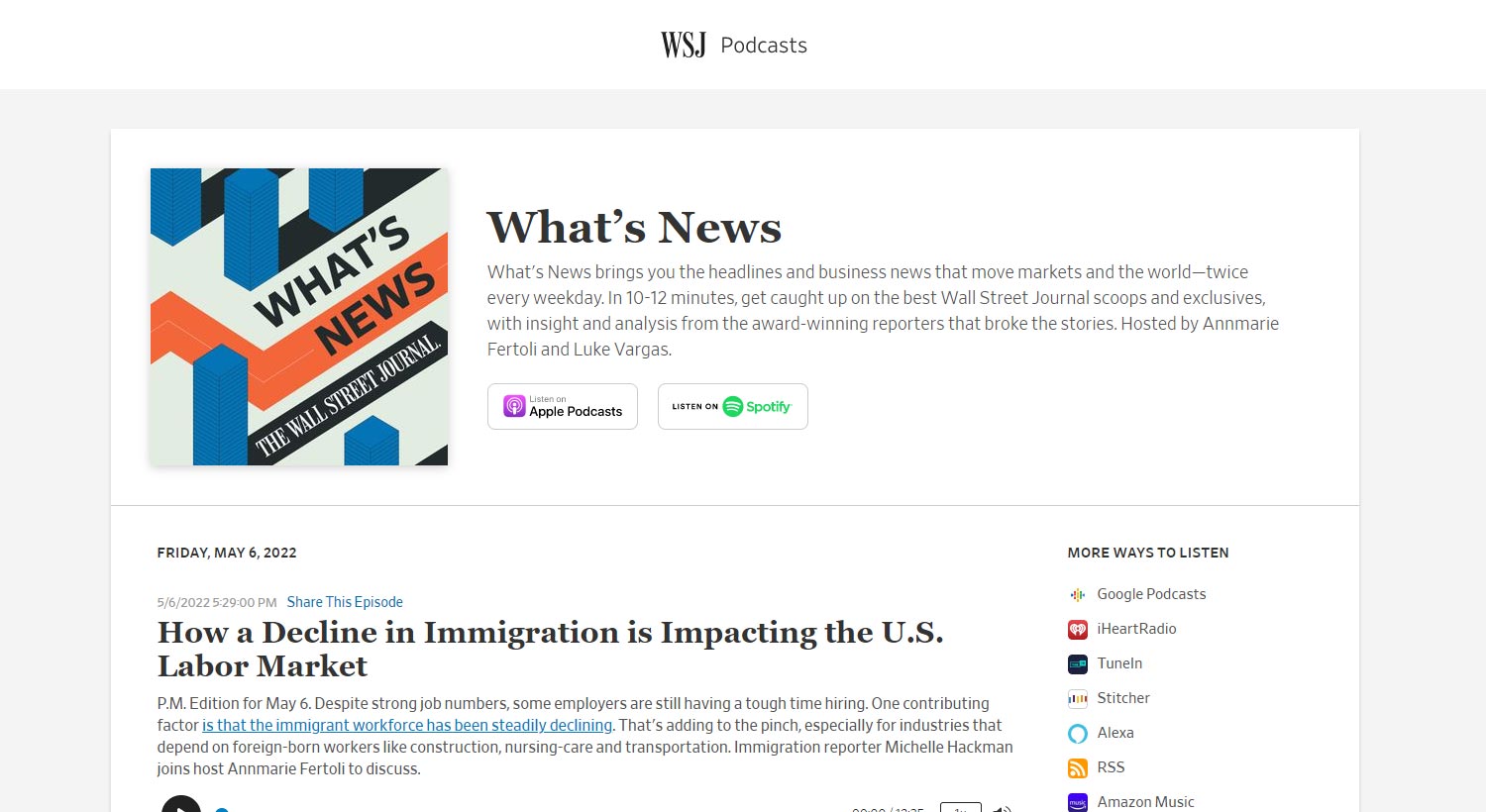P.M. Edition for May 6. Despite strong job numbers, some employers are still having a tough time hiring. One contributing factor is that the immigrant workforce has been steadily declining. That’s adding to the pinch, especially for industries that depend on foreign-born workers like construction, nursing-care and transportation.
FULL TRANSCRIPT
This transcript was prepared by a transcription service. This version may not be in its final form and may be updated.
Annmarie Fertoli: Hiring was strong last month, but a tight labor market is making it tough for some industries to find workers. And a decline in immigration is adding to that pressure.
Adam Lampert: Here in Texas, if you’re trying to get care for your mom or your dad or your aunt, uncle, grandparent, loved one, whoever it is, the costs are simply higher. And the fact that the reality is because we have fewer immigrants available to work has caused inflation.
Annmarie Fertoli: We’ll hear more from some of those on both sides of the crunch. Plus why more companies are hearing crickets from their new employees? It’s Friday, May 6th. I’m Annmarie Fertoli for The Wall Street Journal. This is the PM Edition of What’s News, the top headlines and business stories that moved the world today. U.S. employers added 428,000 jobs in April, marking the 12th straight month of gains over 400,000. The Labor Department says the unemployment rate stands at 3.6%, just above pre-pandemic levels. Economics reporter, Josh Mitchell, says while last month’s gains were broad-based, the leisure and hospitality industry hired the most.
Josh Mitchell: I think the story here is as consumers spend, employers are scrambling to accommodate them. And as long as that continues to happen, I think there’s no sign that job growth is going to end anytime soon. In fact, I think most economists are thinking this could be a pretty solid run of job growth. The biggest question is will the workers be there to hire?
Annmarie Fertoli: Making matters worse, the labor force participation rate or the share of the population with jobs or seeking them fell by two-tenths of a percent to 62.2%. Josh says that drop is a bit of a mystery.
Josh Mitchell: This was the first decline in the labor force since September. Maybe this is just a blip. This happens from time to time. You know, the economy doesn’t always follow in a neat linear fashion. Sometimes there’s ups and downs. You have to look at the long- term trend. So this was a bit of a puzzle, and I don’t think we’ll know the answer for another few months as to what’s going on there.
Annmarie Fertoli: We’ll talk more about which industries are feeling the pinch and how a decline in immigration may be contributing in just a few minutes. It’s been a wild week for U.S. markets with huge swings. But despite the volatility, stocks ended the week not far from where they started it. The S&P 500 and the Dow were each down .2% for the week. The NASDAQ fell 1.5%. Our markets reporter, Sam Goldfarb, says despite positive economic data investors are only focused on one thing.
Sam Goldfarb: It’s really all about the Fed and interest rates and bond yields. We had the jobs report in the morning, which was pretty strong. But right now, investors are just pretty much completely focused on the Fed.
Annmarie Fertoli: In Ukraine, a third group of civilians has been evacuated from a steel plant in the besieged port city of Mariupol. Civilians had taken shelter in the plant when Russia began its siege of the city more than two months ago, and it’s become a focal point in the war in recent weeks. The Ukrainian soldiers have continued to hold out as Russia stepped up its bombing of the facility. The United Nations says almost 500 civilians have been able to escape in two previous operations with assistance. In comments today, Ukrainian President Volodymyr Zelenskyy called for Russia to release the civilians who remain there. Ukrainian officials believe Russia wants to seize the remainder of the city by Monday. And we report exclusively that Chinese tech companies, including PC giant Lenovo and smartphone and gadget maker Xiaomi, are quietly pulling back from doing business in Russia. The companies haven’t made any public announcements, but according to people familiar with the matter they’re curtailing shipments under pressure from U.S. sanctions and suppliers despite calls from Beijing for Chinese firms to resist. According to Chinese government data, exports of tech to Russia plummeted in March compared to a month earlier. Laptop shipments were down more than 40%, smartphones down by nearly two-thirds, and telecom base stations down 98%. The U.S. has threatened to punish Chinese companies that violate the sanctions. Coming up, a declining immigrant workforce is among the factors contributing to a tight labor market. We’ll have more on why after the break. U.S. hiring was strong in April, but it’s still an extremely tight labor market. And employers are having to do more to bring workers in off the sidelines. Labor shortages are stemming from a wide variety of factors, but there is a lesser-known contributor, fewer immigrants in the workforce. For a decade after the 2007 recession, about a million new immigrants came to the country every year. That stream started to slow during the Trump administration and fell to a trickle during the pandemic. Now, economists say there are 2.4 million fewer immigrants of working age in the workforce than if those slowdowns had never happened. And that’s impacting the labor market. Joining me now with more on this is Wall Street Journal Immigration reporter, Michelle Hackman. Hi, Michelle. Thanks for being here.
Michelle Hackman: Thanks for having me.
Annmarie Fertoli: So Michelle, 2.4 million fewer immigrants are in the workforce. Big picture, what effects are we seeing that have on the economy?
Michelle Hackman: 2.4 million immigrants, that’s about 1% of our total workforce in America. But the data shows that immigrants, they aren’t sort of evenly distributed across all jobs, right? Immigrants disproportionately take certain types of jobs that Americans aren’t filling at such high rates. On one end, I would say the higher wage under the spectrum, they’re taking a lot of tech jobs, software engineering, things like that. On the lower-wage end of the spectrum, disproportionate numbers of construction workers, people working in restaurants or hotels and resorts, or in this particular case at nursing homes, the people taking care of mom and dad when they get older tend to be immigrants. So I spoke with Adam Lampert. He is the CEO of a place called Manchester Homes. It’s a nursing home company across Dallas. And he said that about 80% of his workforce tend to be African immigrants from places like Nigeria, Kenya, and recently it’s been much harder to find new recruits because of the slow down in immigration.
Adam Lampert: Here in Texas, if you’re trying to get care for your mom or your dad or your aunt, uncle, grandparent, loved one, whoever it is, the costs are simply higher. And the fact that the reality is because we have fewer immigrants available to work has caused inflation.
Michelle Hackman: Fewer people in the workforce means that wages are going up. There are much larger factors of people quitting their jobs, people retiring early, people sort of switching industries that are creating that sort of upward wage pressure, but fewer immigrants, particularly in these industries like nursing homes, like construction, are probably one of the factors.
Annmarie Fertoli: Michelle, elder care and nursing, as you mentioned, have had their own obstacles due to the pandemic. How has declining immigration fit into their struggles?
Michelle Hackman: Nursing homes are really struggling. You know, 99% of nursing homes report that they have job shortages. And when you think about the types of people who fill the jobs that are currently empty at nursing homes, aides that are helping people get in and out of bed, orderlies that are cleaning bed pans, those are disproportionately immigrants and they’re missing right now. That tracks with something this nursing home manager I spoke to told me. His name is Emeka. He’s an immigrant. And he basically told me there are Americans who are willing to consider this work, but once they hear what goes into it they’re no longer interested.
Emeka: Some of my friends that I would tell about this kind of job, one of them in 2018 I told him about this job. He told me it’s a nasty job. Most of them feel, most of them that are born here feel it’s nasty. You know? They don’t want to do that kind of job.
Michelle Hackman: When he grew up, Emeka had a job working for the government in healthcare in Nigeria. And when he moved to America, he had an interest in continuing to do that, but obviously didn’t have the sort of degrees that we would require for him to get sort of a higher- level administrative job. And so this was his way of sort of staying in his industry.
Annmarie Fertoli: Michelle, what other industries are we seeing being acutely impacted by a reduced foreign-born workforce?
Michelle Hackman: So industries like construction, hospitality, restaurants, hotels, resorts. And we actually had an economist run an analysis for us and he found that these industries sort of that had higher levels of foreign-born workers typically working in them are also some of the industries with the highest job openings right now.
Annmarie Fertoli: How has the pandemic played a role in all of this? Are there other obstacles holding up immigrants from entering the workforce right now?
Michelle Hackman: I would say under the Trump administration, we did see immigration start to go down. Particularly people who were coming to move here permanently applying for green cards, that number started to decline. But it really got sort of slashed in half by the pandemic. And at the beginning of the pandemic, that was because immigration offices around the country and sort of consulates around the world, places you’d go to apply, just shut down. And so what’s happened is even as places are reopening, they have this massive sort of unprecedented backlog of applications and things are taking really, really long for visas or green cards or anything like that to get processed. So one of the really big sort of lesser-told stories about these backlogs is that there are millions of immigrants in the United States who rely on work permits, sort of documents that give them the legal ability to work in this country. And that’s everyone from someone who’s waiting for their green card to come through to a DACA recipient, a Dreamer. That’s one of those kids who was brought to the country illegally as a child and is now covered by DACA, which allows them to work. So there’s a whole range of people. And what’s happened over the last few years is I think what I would call probably a slow-moving bureaucratic nightmare where month to month it’s been taking so long for the government to renew those people’s work permits, that every month about 10,000 people their work permit would expire and the government hadn’t given them a new one. So they just had to stop working. In some cases, their companies had to lay them off and say I really need someone to work, so I’m going to have to hire someone else. And they were sort of left with no job, nothing to come back to even once their new work permit came through. And the government actually came through with a fix for that earlier this week, where they basically said, okay, we know that it’s taking us crazy amount of time to process these work permits. So what we’re going to do is, in most cases people can take advantage of this, you have an exp401Ktion date on your work permit, but you can actually keep working on that work permit for up to 540 days. That’s about a year and a half after that exp401Ktion. And they estimate that’s roughly the amount of time it’s going to take for the government to catch up on this backlog.
Annmarie Fertoli: That’s Wall Street Journal immigration reporter, Michelle Hackman. Michelle, thanks so much for joining me today.
Michelle Hackman: Thank you.
Annmarie Fertoli: And finally, as we’ve been talking about, it’s hard to find workers right now. But some companies are finding that even applicants who go through the interview process and accept offers just seem to disappear. Without saying a word, they’re never seen or heard from again, no call, no email, no show. Our workplace reporter, Chip Cutter, says that’s becoming a big problem.
Chip Cutter: So for example, Southwest Airlines says about 15 to 20% of new hires for some roles aren’t showing up on the first day. The security services provider Allied Universal said they’re seeing about 15% of people do this as well for some new roles. And it’s all kinds of companies. So it’s cleaning companies. It’s some white-collar companies. It’s manufacturers, restaurants. They’re all seeing this in some form. And I think it’s really just caused hiring managers to throw up their hands in frustration.
Annmarie Fertoli: And that’s What’s News for this week. Our hosts are me, Annmarie Fertoli, and Luke Vargas. The show was produced by Trenae Nuri and Kate Bullivant, with help from Mohsin Ali, Anthony Bansi, Daniella Chelow, Julie Chang, Zoe Thomas and J.R. Whalen, and editorial support from Kateri Jochum, Michael Kosmides, and Chris Insley. If you like what you hear, please rate and review us. We’ll be back on Monday morning. Thanks for listening.




